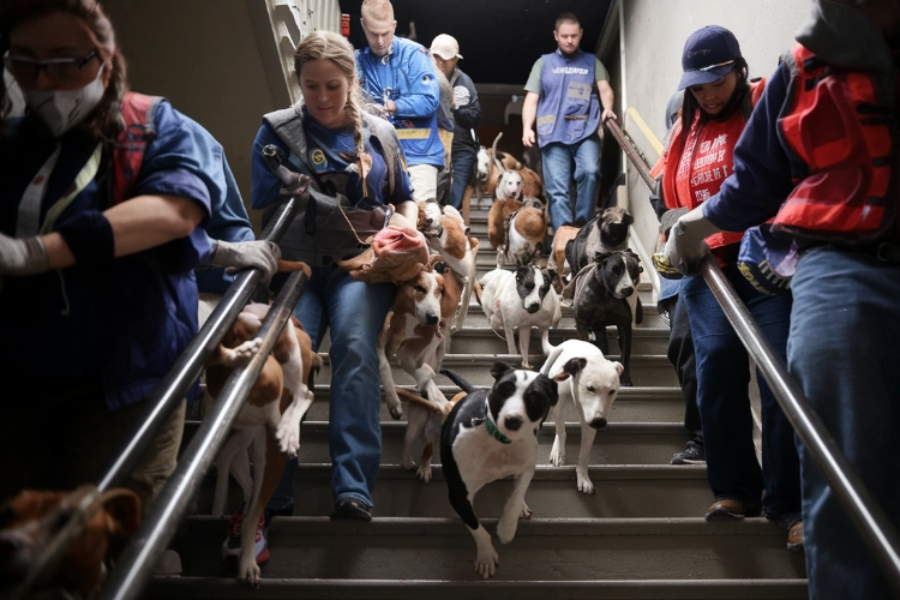Animal hoarding is a psychological condition where individuals gather and keep an excessive number of animals, often beyond their ability to care for them adequately. This results in severe neglect, causing distress, poor health, and sometimes even disease among the animals involved. The 175 Dogs Rescue from Hoarders in Slidell Mississippi 2011 stands as one of the most notable rescue efforts in the area. The event highlighted the critical need for timely intervention in cases of animal hoarding and underscored the importance of community cooperation when it comes to saving animals from harm.
The Discovery of 175 Dogs in Distressed Conditions in Slidell, Mississippi
In 2011, concerned neighbors in Slidell, Mississippi, began raising alarms about a property that appeared to be home to a large number of dogs living in deplorable conditions. Complaints about unbearable odors and frequent sounds prompted local animal control officers to look into the situation. What they uncovered was deeply disturbing—175 dogs living in severe filth, many suffering from neglect, malnutrition, and various illnesses. This discovery marked the beginning of a major rescue operation that would become known as the 175 Dogs Rescue from Hoarders in Slidell Mississippi 2011. The event would highlight the urgent need for intervention and the strength of community collaboration in rescuing animals in desperate situations.
The situation stemmed from a psychological disorder known as animal hoarding, where the individual was unable to provide the necessary care for the animals. The dogs were living in cramped, unsanitary conditions, depriving them of proper nutrition, medical attention, and socialization. As a result, many were in poor health and at risk of further suffering.
A Unified Effort to Rescue 175 Dogs from a Hoarding Situation
The 175 Dogs Rescue from Hoarders in Slidell Mississippi 2011 was an enormous undertaking, requiring the coordination of local authorities and various animal welfare organizations. A combined team of animal control officers, veterinarians, behavioral experts, and volunteers worked tirelessly to remove the dogs from their hazardous environment and relocate them to safe shelters.
The rescue mission involved extensive planning, as many of the dogs had not been exposed to human interaction before and were fearful of contact. Volunteers set up temporary shelters and created a transportation plan to move the dogs to a safe location, where they could receive proper care and attention.
Immediate Veterinary Treatment and Care for the Dogs
Upon rescue, the dogs were quickly examined by a team of veterinarians, many of whom were in poor health due to the harsh living conditions. The dogs faced a range of health issues, including dehydration, malnutrition, untreated injuries, and infections. A number of them also had parasites and severe skin problems, while others exhibited signs of emotional distress.
The medical team immediately focused on stabilizing the animals. Many dogs received treatments for common hoarding-related conditions, such as skin infections and parasites, and several needed surgical procedures. Others required urgent care for their malnourished and dehydrated conditions. The veterinary staff worked relentlessly to ensure that each animal received the care necessary to begin their recovery.
Addressing Behavioral Issues in the Rescued Dogs
A major challenge in the 175 Dogs Rescue from Hoarders in Slidell Mississippi 2011 was addressing the deep psychological trauma many of the dogs had suffered. Animals in hoarding situations often develop severe anxiety, fear, and aggression due to their prolonged isolation. The dogs had been living without proper socialization, and many were terrified of people and other animals.
Animal behavior specialists from various national organizations were brought in to help rehabilitate the dogs. The rehabilitation process involved socializing the dogs, using positive reinforcement to help them build trust, and teaching them how to interact with both humans and other dogs. The journey was slow and required great patience, but over time, many of the dogs overcame their fears and began to show positive signs of healing and increased comfort with human interaction.
Finding Forever Homes for the Rescued Dogs
Once the dogs had been rescued and received the necessary medical care, the next phase of the 175 Dogs Rescue from Hoarders in Slidell Mississippi 2011 was to find them new, loving homes. The adoption process was thorough, with potential adopters carefully screened to ensure they could meet the unique needs of the dogs, many of whom had endured years of neglect.
Animal welfare groups, including the Humane Society and local rescue organizations, helped facilitate the adoption process. Some of the dogs were placed in foster care, where they continued their rehabilitation in a nurturing environment. As the dogs healed both physically and emotionally, many were eventually adopted into homes where they could enjoy the care and companionship they had long been deprived of.
Ethical and Legal Considerations Surrounding Animal Hoarding
The 175 Dogs Rescue from Hoarders in Slidell Mississippi 2011 raised important legal and ethical questions regarding animal hoarding. In Mississippi, hoarding is considered a form of animal cruelty, and those responsible can face criminal charges. The individual responsible for the hoarding in this case was held accountable for the conditions that the animals endured. However, the hoarder was also provided with psychological counseling to address the root causes of their behavior.
Animal hoarding is often linked to underlying mental health issues, and while legal consequences are important, there is a need for mental health interventions to help prevent future cases. The Slidell case emphasized the importance of addressing both the legal and compassionate aspects of animal hoarding, balancing accountability with the support needed for individuals struggling with this disorder.
Raising Awareness: The Widespread Effects of the Rescue Effort
The 175 Dogs Rescue from Hoarders in Slidell Mississippi 2011 drew significant media attention, shining a spotlight on the pressing issue of animal hoarding. Coverage by local news stations like WWL-TV and WDSU helped bring awareness to the severity of hoarding scenarios and the importance of early intervention.
The case not only increased awareness about hoarding but also highlighted the significance of responsible pet ownership. It served as a crucial reminder to the public about the importance of recognizing the signs of hoarding behavior and notifying authorities before situations worsen. The success of the rescue operation emphasized the need for swift action and the strength of community collaboration in ensuring the safety and well-being of animals.
The Enduring Influence of the 175 Dogs Rescue from Hoarders in Slidell Mississippi 2011
The 175 Dogs Rescue from Hoarders in Slidell Mississippi 2011 had a profound and lasting effect on the animal welfare sector. It demonstrated the power of teamwork and the unwavering commitment of animal rescue groups, veterinarians, and volunteers in rescuing animals from harmful situations. This operation proved that even under the most challenging circumstances, recovery and rehabilitation are possible with the right care and resources.
In the aftermath of the rescue, the event prompted the development of new policies and procedures for addressing animal hoarding cases. This helped ensure that authorities and organizations would be better equipped to respond to and manage such situations in the future, offering the appropriate support for both the animals and the individuals involved.
Key Facts
- The Discovery: In 2011, a distressing situation in Slidell, Mississippi, led to the rescue of 175 dogs from a hoarding environment. Neighbors reported unbearable odors and strange noises from a local property, prompting local authorities to investigate.
- The Hoarding Situation: The dogs had been living in unsanitary, confined conditions without adequate care, nutrition, or medical attention. Many of the dogs were malnourished, ill, and suffering from untreated injuries.
- Psychological Factors: The hoarding was linked to a psychological disorder known as animal hoarding, where the individual responsible was unable to care for the dogs due to underlying mental health issues.
- The Rescue Operation: The 175 Dogs Rescue from Hoarders in Slidell Mississippi 2011 involved collaboration between local authorities, veterinarians, animal control officers, and national animal welfare groups. A carefully planned operation was executed to safely remove the dogs from their environment.
- Veterinary Care: Upon rescue, the dogs received urgent medical treatment. Many had to be treated for malnutrition, dehydration, parasites, and infections. Several required surgeries, while others underwent intensive care for physical rehabilitation.
- Behavioral Rehabilitation: Many of the rescued dogs had behavioral issues due to their lack of socialization. Experts in animal behavior helped rehabilitate the dogs, using positive reinforcement techniques to overcome their fear and aggression.
- Adoption Process: After the dogs recovered, they went through a careful adoption process, with many of the dogs placed in foster care for further rehabilitation. Eventually, many of the dogs were adopted into loving homes.
- Legal and Ethical Considerations: The case sparked legal action, as animal hoarding is considered a form of animal cruelty in Mississippi. The hoarder was held accountable, while also receiving psychological support to address the root causes of the hoarding behavior.
- Public Awareness: The rescue operation gained national media attention, helping to raise awareness about the issue of animal hoarding and the importance of early intervention. It highlighted the need for responsible pet ownership and better ways to handle similar situations in the future.
- Lasting Impact: The 175 Dogs Rescue from Hoarders in Slidell Mississippi 2011 became a turning point for the animal welfare community, inspiring new policies, approaches, and increased awareness of how to address hoarding cases effectively.
Final Thoughts on the 175 Dogs Rescue from Hoarders in Slidell Mississippi 2011
The 175 Dogs Rescue from Hoarders in Slidell Mississippi 2011 serves as a powerful illustration of what can be accomplished when communities unite for the sake of animal welfare. This case highlights the importance of vigilance, compassion, and the availability of support systems for both the animals and the individuals affected by hoarding behaviors. As we reflect on this rescue, we must continue to prioritize awareness, encourage responsible pet ownership, and ensure that animals in similar situations receive the care and attention they need.
Common Questions Answered
How were the 175 dogs rescued in Slidell, Mississippi in 2011?
The rescue of the 175 dogs was a collaborative effort involving local authorities, animal control officers, and national animal welfare groups. A dedicated team of volunteers and veterinarians worked around the clock to safely remove the dogs from their harmful environment and provide medical care.
What happened to the dogs after their rescue?
After being rescued, the dogs underwent thorough medical treatment and behavioral rehabilitation. Many of them, once they recovered physically and emotionally, were adopted into loving and responsible homes.
What legal actions were taken against the hoarder?
The individual responsible for the hoarding was held accountable under Mississippi’s animal cruelty laws. In addition, psychological counseling was provided to address the underlying mental health issues contributing to the hoarding behavior.
How can we stop future cases of animal hoarding?
Preventing future hoarding situations requires increasing awareness of the problem, providing mental health support for those at risk, and promoting responsible pet ownership within communities. These efforts are essential for preventing the cycle of neglect and hoarding from continuing.
Stay in touch to get more updates & alerts on Live Hint! Thank you



